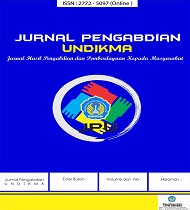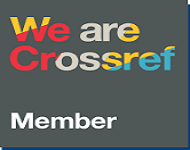Pengembangan Media Pembelajaran Alignment pada Pulley dan Kopling Menggunakan Metode Cahaya Laser dan Dial Indicator pada Mata Kuliah Praktik Alignment
DOI:
https://doi.org/10.33394/jk.v7i2.3197Keywords:
Learning Media, Alignment, Laser, Dial Indicator.Abstract
References
Azwar, S. (2013). Reliabilitas dan Validitas. Yogyakarta: Pustaka Pelajar.
Darmawan, dkk (2016). Misalignment Kopling dengan analisis sinyal getaran kondisi Steady state menggunakan metode reverse.Jurnal teknik mesin S1,Vol 4(2),197-206, http://ejournal-s1.undip.ac.id/index.php/jtm
Darto & Sudjatmiko. (2015) Mekanisme Proses Alignment Poros Mesin Rotasi Berbantu Perangkat lunak, Jurnal info teknik, Vol 16 (1),11-20
Dodi Budi Laksono, h.r. (2018). Rancang Bangun Media Pembelajaran Setting Alignment. Jurnal teknologi dan terapan bisnis,1 ,38-43.
Kd.Ayuning R, dkk (2016). Analisis Faktor-Faktor Yang Mempengaruhi hasil Belajar Bahasa Indonesia pada siswa Kelas V Sd Gugus VI. e-Journal PGSD Universitas Pendidikan Ganesha Jurusan PGSD Vol: 4 No: 1 Tahun: 2016. https://ejournal.undiksha.ac.id/index.php/JJPGSD/article/viewFile/7454/5081
Lifetime Reliability Solution. (2012). Precision Maintenance Tehniques For Machinery. Machine Installation-Shaf Alignment, hal. 17.
Mulyatiningsih, E. (2013). Metode Penelitian Terapan Bidang Pendidikan. Bandung: Alfabeta.
Nunu M (2012). Kajian Terhadap langkah-langkah pemilihan media dan implementasinya dalam pembelajaran, Jurnal Pemikiran Islam; Vol. 37, No. 1 Januari-Juni 2012. http://ejournal.uin-suska.ac.id/index.php/Anida/index.
Rudi Susilana, C. R. (2011). Media Pembelajaran: Hakikat, Pengembangan, Pemanfaatan, dan Penilaiaan. Bandung: CV. Wacana Prima.
Sugiyono. (2019). Metode Penelitian Pendidikan. Bandung: Alfabeta.
Suharsimi. (2011). Prosedur penelitian: Suatu Pendekatan Praktik. Jakarta: Rineka Cipta.
SKF. (2012). Rolling Bearings. Shutterstock.
Sukoco, Bhimo dkk. (2019). Pemahaman Pendidikan Vokasi Di Jenjang Pendidikan Tinggi Bagi Masyarakat. Jurnal Pendidikan Vokasi, Vol 1, No 1, http://ejournal-s1.undip.ac.id/index.php/jtm.
Tafanao, Talozaro. (2018). Peran Media Pembelajaran Dalam Meningkatkan Minat Belajar Mahasiswa. Jurnal Komunikasi Pendidikan, Vol 2, No 2, http://journal.univetbantara.ac.id/index.php/komdik/article/view/113/0.
Tauvana Irvan A (2018). Alignment Kopling dengan metode double dial indicator rim and face. Jurnal Simetris, Vol 9 No 1, https://jurnal.umk.ac.id/index.php/simet/index
Undang-Undang Sistem Pendidikan Nasional. (2013). PP No.20 Tahun 2003. Jakarta: Sinar Grafika
Downloads
Published
How to Cite
Issue
Section
Citation Check
License
License and Publishing Agreement
In submitting the manuscript to the journal, the authors certify that:
- They are authorized by their co-authors to enter into these arrangements.
- The work described has not been formally published before, except in the form of an abstract or as part of a published lecture, review, thesis, or overlay journal.
- That it is not under consideration for publication elsewhere,
- That its publication has been approved by all the author(s) and by the responsible authorities tacitly or explicitly of the institutes where the work has been carried out.
- They secure the right to reproduce any material that has already been published or copyrighted elsewhere.
- They agree to the following license and publishing agreement.
Copyright
Authors who publish with JK agree to the following terms:
- Authors retain copyright and grant the journal right of first publication with the work simultaneously licensed under a Creative Commons Attribution License (CC BY-SA 4.0) that allows others to share the work with an acknowledgment of the work's authorship and initial publication in this journal.
- Authors are able to enter into separate, additional contractual arrangements for the non-exclusive distribution of the journal's published version of the work (e.g., post it to an institutional repository or publish it in a book), with an acknowledgment of its initial publication in this journal.
- Authors are permitted and encouraged to post their work online (e.g., in institutional repositories or on their website) prior to and during the submission process, as it can lead to productive exchanges, as well as earlier and greater citation of published work.
Licensing for Data Publication
-
Open Data Commons Attribution License, http://www.opendatacommons.org/licenses/by/1.0/ (default)

This work is licensed under a Creative Commons Attribution-ShareAlike 4.0 International License.







